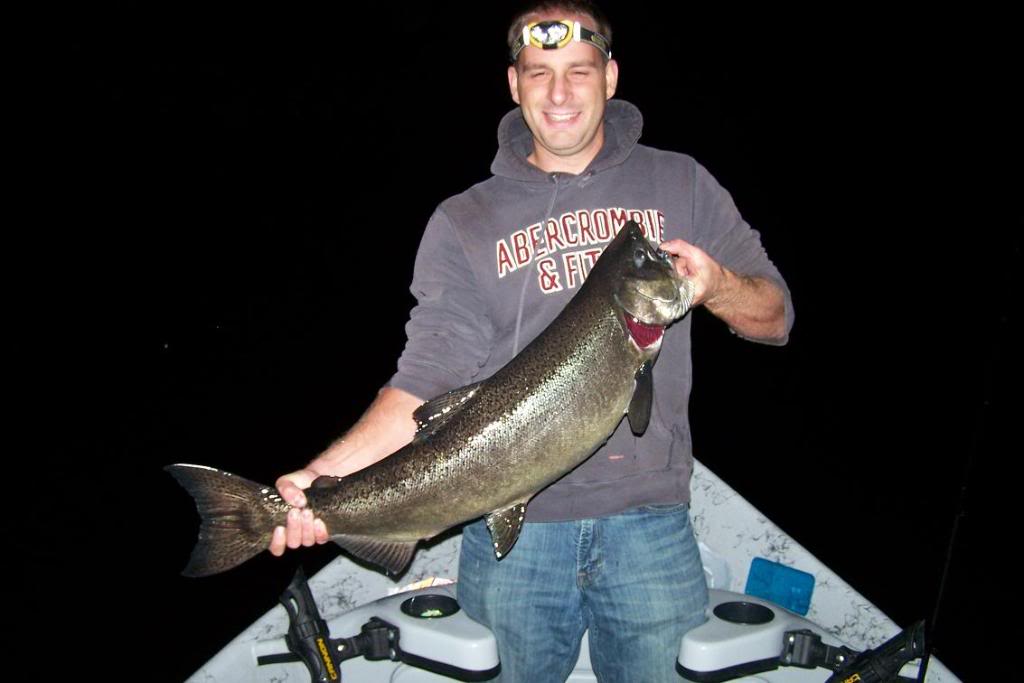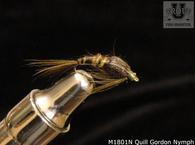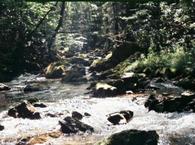
Known to some as "The Poor Man's Alaska", the Salmon River located in Pulaski, New York boasts some of the areas best salmon, steelhead, and brown trout fishing on the East Coast. Being a short drive from many states, it can bring in a mixed bag of people. From fly fishing to spin fishing you will see a many different styles of fishing on the river at any given point of the year. The busy season is during the Fall, when large runs of salmon migrate out of Lake Ontario into the Salmon River to spawn. The river boasts two fly fishing only sections above the Altmar bridge. They have closed seasons so be sure to check regulations for that time. Traditional fly fishing equipment is all that is allowed and these areas are very heavily fished.
Early in September the salmon will begin to move in from their deep dark haunts of the lake and begin to stage in the estuary of the Salmon River. Typically the salmon begin entering the river once the water has cooled to below 60 degrees fahrenheit and the flow of the river is above 385 cubic feet per second (cfs). This can vary year to year according to rain and weather. We have seen fish in the river as early as Labor Day Weekend. Starting in September there is a minimum flow of 335 cfs that is released from the dam. Regardless of what the temperature is the river, the salmon will begin to enter the river by the second to third week of September. Most of the big runs of salmon wont occur until there is a significant change in the water level of the river. An increase of 200 cfs or more, is enough to make the salmon push up from the estuary into the main stem of the Salmon River. One can be certain that with the salmon run comes the crowds of people. Once a good run of salmon has pushed into the river, the monster lake run browns and steelhead are not far behind.
The steelhead and browns enter the river to eat the salmon eggs as well as spawn. Unlike the salmon, the browns and steelhead will not die after spawning. A good day in the Fall can consist of catching a variety of species while fishing the river. When the steelhead and browns first enter the river, they are verry aggressive and will eat a wide variety of offerings. Many people will swing buggers or spey flies, but most will stick to the egg patterns since that is what the fish are keyed in on. Many fisherman, both fly fisherman and spin fisherman, will use a tactic straight from the rivers of Alaska. This tactic is a plastic bead ranging in size 6mm-10mm that imitate the salmon eggs being dropped by the millions in the river. With more colors then you can shake a stick at, you are certain to find the right color for the day that the fish are keyed in on. This tactic can be deadly and cause sore mouth syndrome on many fish, as well as cause you to have a sore arm.
Regardless of the tactic you use to target these fish, one of the most exciting can certainly be swinging flies. Whether you're using a single handed rod or a two handed spey rod, you can be successful. The numbers of fish may not be as high as some of the other tactics, but you can be certain the strikes will be much harder and the fish a lot hotter taking you well into your backing. The fish that are striking swung flies are the most aggressive in the river and will be sure to take you for a ride.
A good tool to have is knowledge of the waterflow as well as a map of the Salmon River. For the most part the Salmon River will run gin clear even in high water (as long as the release is from the dam). During periods of heavy rain and spring runoff the river can get very high, so be safe when wading and don't risk your life for a fish. There are two small tributaries that dump into the Salmon River that will cause the water to become dirty during heavy rain or spring run off, these are Trout Brook and Orwell Creek. You can stay above the first tributary, Orwell Creek, during heavy rains and spring run off and still fish cleaner water.
Spring: March through April. Spring steelhead fishing can be very intense. Known as "drop back" season (because the fish are dropping back to the lake, they are on a feeding frenzy and eating just about everything. It is not uncommon to have 20 plus fish days. With the warmer weather comes more fisherman, so expect to see larger numbers of people on the water. You can get away from the crowds in a drift boat or if you're willing to walk.
Summer: May through August can be tough for trout as the water has come down and the river temps have gone up. There are atlantic salmon and summer run steelhead that work their way into the river during water releases. These fish are tough to come by and will usually shoot straight up towards that hatchery and lurk in the deeper holes near the hatchery. However, you can catch lunker small mouth bass that move into the river during the summer months. It is not uncommon to catch 2lb small mouth in some of the deeper runs of the Salmon River.
Fall: September through the end of October are some of the busiest days on the river. This is when the chinook and coho salmon make their way up the river to spawn. The fishing can be intense all day long if you find yourself fishing an over cast day and the fish are constantly on the move. Expect the steelhead and browns to make their way into the river about the middle of October once the salmon have been in the river for a few weeks.
Winter: November through February are the months when you will find mainly steelhead and browns in the river. Once in a while there are a few confused salmon lurking around, but they are far and few between. Fishing into December can be great, but once the very cold temps roll in expect to work harder to feel a head shake. There are days when it seems the fish have lock jaw during the winter, but don't be fooled, they are eating something.
The majority of the fishable portions of the Salmon River are public access, except for the lower two miles of the river which are a pay to fish portion. This however, is just a two mile stretch, and there is PLENTY of public access water that you can fish. Much of the public access water and shoreline is on private property, so please respect people's property and leave the area cleaner then you found it.
Studded boots are a must on the Salmon River. Just felt simply wont do, especially in the winter. Be sure you have the proper foot gear if you plan on wading. There are also four public access drift boat launches for boat owners to use. If running a driftboat be sure of the flows before you drag your boat out there. You can float the upper portion of the river (Altmar to Pineville) in as low as 335, but you will be cleaning the bottom of your boat on the rocks. If you wish to float mid-river (Pineville to 2A) you should wait until the water is 750 cfs or higher. Lower river (2A to the Ball Park) should be floated in 750 cfs or higher. These flow rates are just a guide line and you can run your boat in any level you so choose. The Salmon River is a very technical river below the Pineville ramp, and I would caution fisherman who have never floated the Salmon River to go with someone who is experienced on the oars in this section of river and the section of river below.
A special thanks to Christopher Tobias who provided this report. Christopher has been a steelhead guide on the Salmon River and now is getting ready for a deployment to Afghanistan with the Army. Previously he server in the Marines for 8 years. He is also co-owner of the Great Lakes Steelhead Company.





